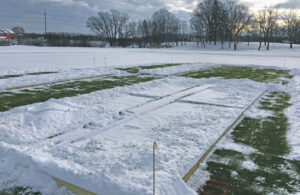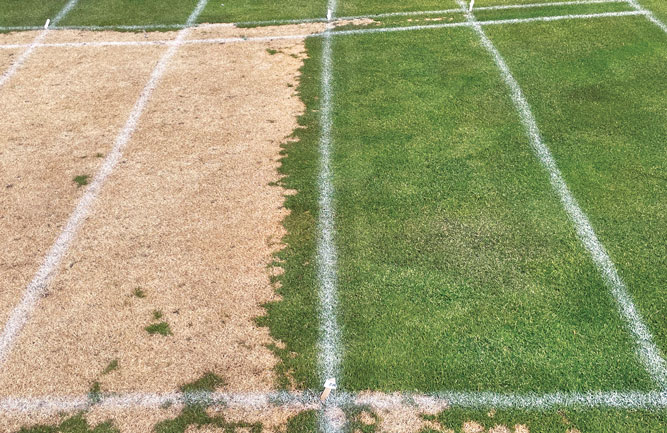Super Science: A year of research in review
Many will remember 2020 for COVID-19, protests and a contentious election.
I want to look back at all the great information provided by turfgrass scientists. Golfdom offers an excellent platform for researchers to help you. I hope you find a summary of the research takeaways helpful as we wrap up 2020.
Dollar spot susceptibility of bentgrasses
By Cole Thompson, Ph.D.
The turfgrass trials show that cultivar selection matters when considering dollar spot disease.
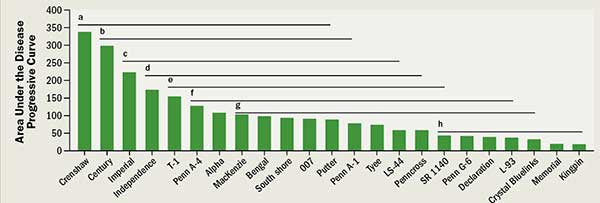
Figure 1 Dollar spot injury (measured as an area under the disease progress curve) for bentgrass cultivars at putting green height and without fungicide treatment. These data are a mean of responses in Kansas and Wisconsin in 2009, as well as Kansas, Iowa, Oklahoma and Illinois in 2010. Means under the same horizontal bar are not statistically different according to Tukey’s honest significant difference test (P ≤ 0.05).
- Dollar spot severity varied for bentgrass cultivars within experiments and was generally less with fungicide applications and for the putting green study.
- Overall, however, a cultivar’s relative susceptibility to dollar spot injury was similar in putting green and fairway experiments with or without fungicide applications.
- Kingpin and Memorial had the least dollar spot injury under all scenarios (putting green and fairway, with and without fungicide).
- Crystal BlueLinks, Declaration, L-93 and SR1150 were consistently similar (Figure 1).
- Crenshaw and Century had the most dollar spot injury in all scenarios and were never in the same statistical group as the best cultivars.
- Further, dollar spot injury data were consistent in each experimental location and management scenario.
- Golf course superintendents should feel comfortable using the National Turfgrass Evaluation Program or similar data to assess relative dollar spot susceptibility of bentgrass cultivars, even when close-proximity data are not immediately available.
Moving fungicides down in soil
By Wendell Hutchens, Travis Gannon, Ph.D., David Shew, Ph.D., Khaled Ahmed and Jim Kerns, Ph.D.
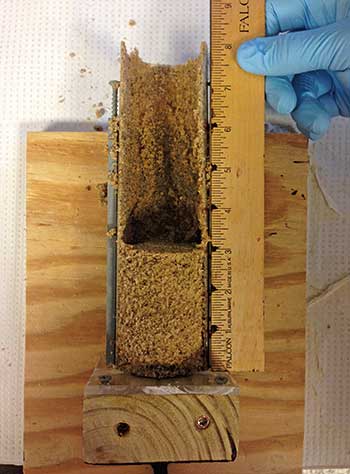
Photo 1 Sectioning soil into 1-inch increments to recover applied 14C-fungicide. (Photo: P. Maxwell)
Soil surfactants can help get fungicides where the pathogen attacks the turfgrass (Photo 1).
- Diseases caused by crown- and root-infecting pathogens require products and methods that effectively aid their downward movement.
- Soil surfactants applied in combinations with fungicides increase the downward movement and efficacy for crown- and root-infecting pathogens.
- The research recommends applying fungicides with a water carrier volume of 2 to 4 gallons per 1,000 square feet with irrigation of 0.125 to 0.25 inch of water immediately after fungicide application.
A new pest in the desert Southwest
By Adam Van Dyke, M.S., CPAg, and Ben McGraw, Ph.D.
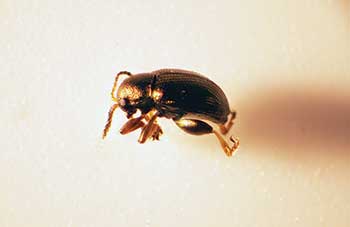
Photo 2 Flea beetle (Photo: Ben McGraw)
The two researchers discuss the emerging flea beetle pest problem.
- The Southwest U.S. has an emerging insect identified as Chaetocnema minuta Melsheimer or flea beetle.
- The flea beetle (Photo 2) is relatively small — 0.08 to 0.12 inch in length — and has a dark metallic coloration.
- More research is needed to answer basic questions surrounding the pest’s biology, ecology and management in turfgrass systems.
- Turf damage primarily on perennial ryegrass originates in the golf course rough that borders native areas.
- Limited data suggest adults lay eggs in the fall, and some eggs or larvae overwinter within the turf.
- The larval activity was detected in April but peaked in July in southern Utah.
- Controlling adult populations with contact insecticides will require extreme precision in timing.
- Larvae are less likely to be affected by contact insecticides as they are protected within the plant’s stem, and preventive applications with systemic larvicides may be more appropriate.









